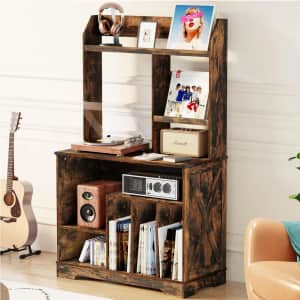
It's $50 off. It's available in Rustic Brown or Rustic Grey. Buy Now at flycitymall.com
- three compartments
- adjustable board
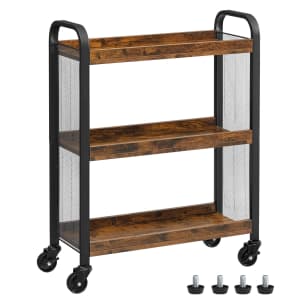
It's 40% off. Shipping takes about a week. Buy Now at Amazon
- wheels and adjustable feet
- measures 11.4"D x 26.6"W x 33.5"H
- Model: ULRC66BX
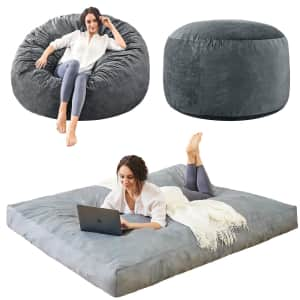
Clip the 30% off on page coupon and apply code "7NCDP5GQ" to get this deal. It's available in several size/color variations. Shop Now at Amazon
- machine washable cover
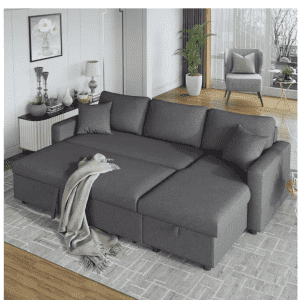
Get 40% off this convertible sofa. Buy Now at Home Depot
- wooden frame
- built-in storage unit
- high density foam cushion
- Model: WYT107EAA
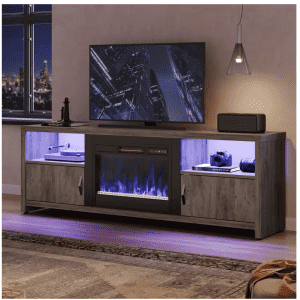
Get the best price we could find by $75. It's available in Wash Grey at this price. Buy Now at Home Depot
- 20-colors and 22-dynamic modes
- adjustable shelf
- measures 70.8" W x 23" H x 14" D
- Model: L101217ZFP
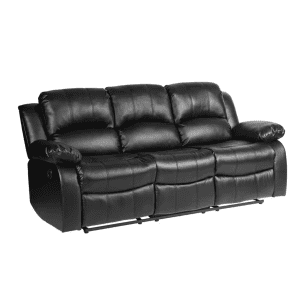
Get just over 30% off this comfy sofa. Buy Now at Home Depot
- removable seat backs
- attached back and seat cushions
- solid wood and plywood frame with metal reinforced seat
- Model: 9700BLK-3

Get $8 off and carry it anywhere you go. Buy Now at Home Depot
- removable and washable cover
- Model: HD-RLE-003T

Shop a range of height adjustable and corner desks. We've pictured the SHW 48" x 24" Memory Preset Electric Height Adjustable Standing Desk for $119.90 ($30 off). Shop Now at Amazon

It's the best price we could find by $10. Use it in any room. Buy Now at Home Depot
- measures 60" x 27" x 60"
- Model: 59939
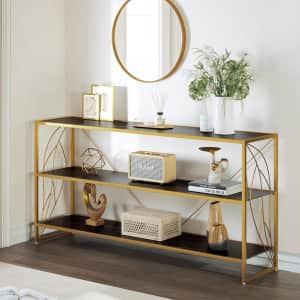
DWVO via Amazon offers the DWVO Entryway Console Table for $159.99. Coupon code "50RRG3AI" cuts it to $79.99 with free shipping. Buy Now at Amazon
- measures 15" D x 60" W x 30" H
- three shelves
- 30 minute assembly time

Display books, plants, and more. It's $27 off. Buy Now at Home Depot
- made from high-grade aluminum and MDF
- tempered glass doors
- measures 63" x 31.5" x 15.7"
- Model: KF020275-01-c
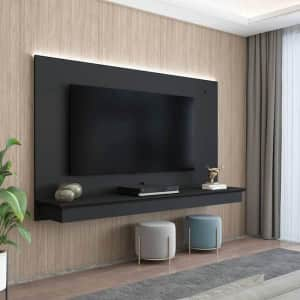
That's a savings of $58 and a nice drop since our last mention. In Black, Natural, or White.
Update: The price is now $178.27. Buy Now at Home Depot
- fits up to 65" TVs
- measures 39" x 65" 13"
- cable management
- LED light strip
- Model: 13446HD

Kohl's charges $105 more. Buy Now at Home Depot
- 73.5" x 73.5" x73.5"
- Adjustable shelves
- CARB-compliant, laminated composite woods with an MDF backer
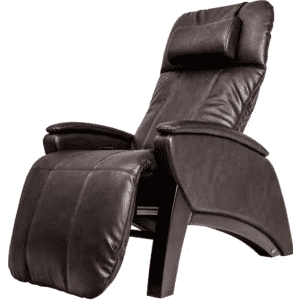
Shop over 350 discounted items, with carts and shelving from $38, side tables and stools from $61, bed frames from $81, and desks from $105. We've pictured the Titan Sonno XT-2 Series Powered Recliner Massage Chair for $1,849 - a $1,650 discount. Plus, most items ship for free; if not, in-store pickup is generally available to avoid oversize shipping charges. Shop Now at Home Depot
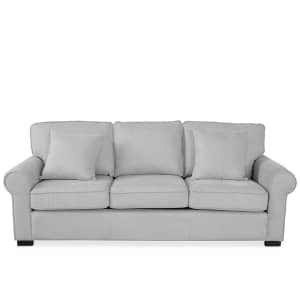
Shop the lowest prices of the season on furniture, mattresses, rugs, and outdoor. We've pictured the Kariam 90" Fabric Sofa for $499 ($500 off). Shipping varies by location, but patio furniture priced $999 or more ships free, as marked. Shop Now at Macy's
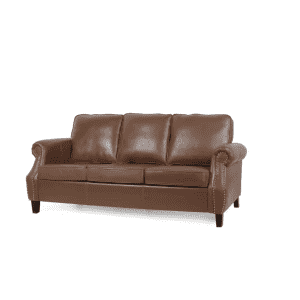
Get the best price we could find by $421. It's available at this price in Cognac Brown and Dark Brown. Buy Now at Home Depot
- measures 33.5" D x 80" W x 37" H
- Model: 109046

Spruce up your living space this spring with deals on tables, dining chairs, kids' furniture, beds, and more. We've pictured the Woven Paths Pascal 73" Fabric Sofa Couch for $187 (savings of $161). Orders of $35 or more ship free; otherwise, opt for in-store pickup to avoid the $5.99 shipping fee. Shop Now at Walmart
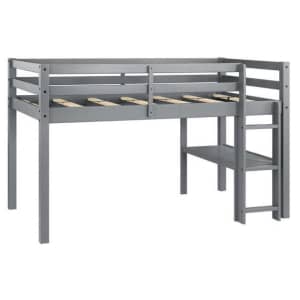
That's a $16 savings. Buy Now at Walmart
- measures approximately 79" x 44" x 48"
- Model: BHF1025004006
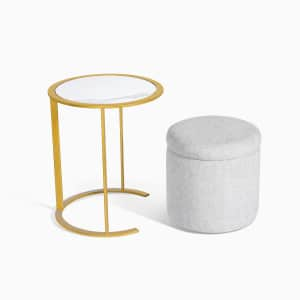
DWVO via Amazon offers the DWVO Marble Round End Table for $109.99. Coupon code "403KL8PS" cuts it to $65.99 with free shipping. Buy Now at Amazon
- white sintered stone tabletop
- 20" diameter, 23.6" height
- Includes round storage ottoman
How to Shop and Save on Home Furniture Deals
Americans spend most of their money on housing , which includes the cost of furnishing these homes. It’s a significant expense and one that can be complex in terms of what to buy and how much to spend, especially considering these items may spend years in your home. It’s a purchase often made in a store where items can be seen, touched, and tested.
Increasingly, however, furniture purchases are being made online. It’s projected to be the fastest growing e-commerce segment through 2022 and some estimates say 19% of furniture and bedding sales will be made online by then, up from 14% in 2017.
Whether you buy online or in-store, you may have questions about purchasing or how to find the best deals on furniture. We’ve covered many common questions below.
Home Furniture Blog Articles
Top 8 Stores for Online Deals on Furniture
These stores are popular on DealNews for furniture deals online:
Types of Home Furniture
Here are some of the kinds of furniture pieces you can find on DealNews:
Frequently Asked Questions
Should I shop for furniture online or in-store?
Customers are starting to buy furniture online more frequently than before. The advantages are convenience, a wide selection of options at your fingertips, and the ability to quickly price check and compare to get the best price. You don’t have to deal with traffic or pushy salespeople, who may convince you to spend more than you intended.
The advantage of shopping in-store is the ability to physically inspect the item, view the actual color (which can look different online), and sit on the furniture to ensure it’s comfortable and sturdy. Although we mentioned pushy salespeople, many are genuinely helpful and provide personalized assistance you won’t get online.
Whether you shop online or in-store also depends on what you are buying. A purchase of a table largely involves shopping for the desired materials and dimensions if you like the look. Comfort isn’t a factor, so it’s generally a straightforward purchase to make online.
If it’s a pricey sofa and you aren’t at ease about buying it without seeing it and testing it for comfort, you may want to head out to the stores. You can also take a hybrid approach, where you try out some models in the store and later search online to compare prices.
Regardless of whether you shop local or on the web, you’ll want to check online reviews for the store to get an idea of the level of customer service offered or any significant issues to watch for. Then you can search or inquire about the store’s return policy in case your items are damaged in transit or don’t work once they are in your house.
What about getting the furniture home? Unless you know of a local store that keeps inventory on-hand (this is certainly an important question to ask while shopping), most larger pieces of furniture will have to be ordered regardless of whether you purchase online or in a store. It’s not unusual for it to take weeks to be delivered either way.
How much does furniture delivery cost?
This will vary a lot depending on the store and the size of the items purchased. The most vital thing to know is what your shipping options include. There are various online stores that offer free shipping on furniture, but don’t assume this means actually getting the piece into your house. It may be curbside delivery, where it’s lowered off the truck and placed at the end of the driveway — or it might be set on the porch or in the garage. You’ll need to be prepared with people to help move it inside.
If you need more assistance, you can shell out for White Glove, premium, or full service delivery. These options typically start around $100, but can go much higher. It involves bringing the furniture inside the house, assembling it, and removing packaging. Be sure to check with the retailer to determine the exact services included in the price and whether assembly is required.
You may balk at the cost initially, but upgraded delivery can be worth paying for in some cases. If you’ve opted for a large power reclining sofa with lumbar support and adjustable headrests, the electric parts make the item extremely heavy. It may not easily fit through the door, and assembling and hooking it up may prove to be quite difficult.
How can I ensure the furniture will work for me and fit in my space?
Before buying furniture, it’s important to evaluate your space and measure everything. It’s not only about the length, or whether something will fit across a certain wall in a room, for instance. It’s also about depth, or how far it will extend out into the room, particularly in relation to other pieces.
Unless you are working with a very large space, furniture will often look much larger in your home than in the store. Big, overstuffed living room furniture may be appealing, but it can be difficult to fit to the scale of a smaller room. Likewise, a large room may engulf smaller pieces. Your furniture shouldn’t completely overwhelm or underwhelm the space.
If you’ve found an option you are strongly considering, get the measurements and compare it to the measurements of your room. You can even use masking tape to lay it all out, or just mark off the end points for length and depth. This helps you to get a better idea of the proportions.
Additionally, you will need to measure your door and, if applicable, any stairs or hallways to make sure the furniture will fit. Standard doorways are around 36 inches wide, but can be less. If the furniture is a bit wider than that, there may be wiggle room if the furniture is soft, can be angled, or partially disassembled. Removing the door from the frame also gives some extra space to work with.
Besides the technicalities of measurements, it’s important to think about what you want and need out of the furniture. Make a list of must-haves and consider the things that will eliminate nagging issues. Are you tired of random things collecting in the space under the sofa or constantly pushing in cushions that come out? You might choose an option that sits low to the ground and has semi-attached cushions to solve these issues.
Looks are important, but don’t choose based on aesthetics alone. If you are in the store shopping for a couch or chair, take a seat for as long as you need to — make sure you are comfortable and it doesn’t sit too high or low. If you like to sleep on the couch occasionally, consider whether it’s long enough, wide enough, and cushioned correctly to take a cozy nap.
When it comes to tables or cabinets, pull out the drawers and open the doors. If they aren’t smooth or functioning particularly well in the store, that will likely be magnified once it’s in your home.
Don’t settle on something thinking you’ll fix it later or buy something else sooner than you think. Sometimes several years will pass and circumstances haven’t dictated replacing anything, plus the cost of things like reupholstering or replacing cushions can be high. So, be picky and take your time to find something you love.
What should I consider in terms of color and materials, especially with kids and pets?
Choosing new furniture is strongly driven by lifestyle, with kids and pets often being heavy influencers of what’s selected. (Yes, your cat will likely dictate your choice of couch.)
When it comes to materials, one big choice customers face is whether to buy leather or fabric. Genuine leather ages well and is luxe, durable, and resistant to odors. It’s easy to wipe off pet fur from the surface. That said, it’s also a larger investment compared to its fabric counterparts, and blemishes or tears aren’t so easy to fix.
It’s often said that cats don’t like scratching on real leather or that it’s strong enough to resist damage; however, there are mixed reports on this topic and it depends on the type of leather selected (and the cat).
Leather can also be susceptible to dye transfer or staining from things like dark blue jeans or wine spills. This is especially prominent on lighter colors, so that’s something to consider even if you don’t have pets or kids. If you spring for it, just be sure to have products for treating dye transfer or stains on hand. In a pinch, a few common household items, like baking soda, can be used to clean stains on leather.
If you are shopping for leather, keep in mind that something that appears to be leather may be bonded or faux leather instead. There are different levels of quality with these materials, but they are more likely to crack or peel over time — and cats can more easily sink their claws into this type of surface. Although cheaper than genuine leather, this type of irreparable damage can still hit your pocketbook hard.
Some furniture only has genuine leather in areas the body touches, so the sides and the back of the piece are a faux leather match. These are the areas most susceptible to cat scratches, so it’s something a pet owner would need to be aware of before making a purchase. A full leather coach will be higher in price, but it may be worth paying extra if you have faux leather concerns.
You might come to the conclusion that the investment in leather isn’t a good idea for your circumstances. When it comes to fabric, avoiding very light colors and choosing subtle prints in a mix of shades can go a long way to camouflage stains from kids or pets. Pet fur really stands out on dark fabric and it may be difficult to remove, particularly if the fabric is velvet or highly textured. The cat will love to scratch these textures as well. If this concerns you, look for stain-resistant fabrics with a smoother texture in medium shades.
Regardless of the material you choose, you’ll want to inquire about purchasing a warranty and whether it will cover stains and damage, particularly whether pet damage is included.
Outside of lifestyle factors, the color you choose will depend on your preferences. If you love that beautiful bright teal couch, go for it! We only advise giving it some thought. Will you still love that color for years down the road? Unless you have a large home decorating budget, you may have to live with this choice for a long period of time and your tastes may change. If you go neutral and classic with your larger furniture pieces, you can alway add bold color and style through accessories like throw pillows, rugs, curtains, and other decor. Then it becomes easier and less expensive to change things up on a more frequent basis.
Furniture is expensive, so how can I afford it?
In an ideal situation, one could pay outright for their new furniture; however, it can be a large expenditure and this isn’t feasible for many people. Furniture stores often entice customers with special interest-free bank financing, and the agreements can go anywhere from a couple months to several years. Or, the store may offer a credit card with similar terms.
If you decide to finance your furniture, know ahead of time what payment you can afford. You should always plan to pay it off completely within the special financing period with no interest. Otherwise, once this period is over, retroactive interest will be added starting from the beginning of the loan, and you may end up paying hundreds of extra dollars.
You’ll need to do your own calculations. The store may quote you a minimum payment amount that will not pay the furniture off completely during the interest-free period — and they may not mention this fact, either. You can take your total and figure out how much you actually need to pay per month to avoid interest fees. Don’t forget to factor in your complete total, including extra costs like taxes and an extended warranty if you purchase one.
If the payment amount is anxiety-inducing, take a step back and give it some thought. Nothing is worth buying if it doesn’t fit your budget, and will cause you stress. You can reduce your purchase amount or forgo the purchase completely, opting to save money for a while or buy used for much less.
The key here is patience. You don’t have to replace everything in your home at once. Prioritize the things that make the most impact in the commonly used areas in your home. Even if you can only afford one great high-quality piece, do that and mix it with your existing furniture or lower-priced items. Some of the most interesting rooms are a conglomerate of colors, patterns, and textures with mix and match styles. Once you have the means, find another great piece and keep going.
To save money, you can also consider negotiating. First, don’t apply for financing until everything is negotiated and finalized. Otherwise, the salesperson will know how much you can actually spend, even if it’s not in your plans to use the full amount you got approved for. Then, just ask if any discounts are available. If you are turned down, be persistent. Furniture is notorious for high markups, so in most cases there is a price margin to work with. It’s common to be denied at first, which puts many people off from asking again.
If you spend a few more minutes with the salesperson, you might find a different angle; for instance, if you are interested in a couch with a matching recliner, see if you can get a discount on the bundle.
Knowledge is important here, such as whether the retailer is offering discount codes or a lower sale price online or what competitors are offering for the same or similar items. It’s more likely to be approved if it’s a price match of the store’s own online prices or what’s offered elsewhere by the competition.
If you are online, call or chat to request a discount. It isn’t guaranteed, but it never hurts to ask. Again, if you have information on a matching competitor price, the store may have a policy already in place for price matching and it’s more likely to be approved.
Is it better to spend more or spend less on furniture?
It’s generally a good idea to go high or low, but avoid the midrange. The cost of frequently replacing low-end furniture can exceed the cost of shelling out for longer-lasting, high-end pieces. Go high if you can with large scale items and stick with timeless silhouettes and colors, rather than the latest fad or trend.
That said, price does not always equate to quality. Low-priced furniture can be very durable and comfortable. You don’t necessarily have to pay a lot, especially for young adults getting their first place, or anyone on a tight budget. Or, you might just have a preference for spending less or expect to replace your furniture in a relatively short period of time. These are all good reasons to go low.
Finally, be sure to check here at DealNews for all the best furniture deals we could find that will help you save on your next purchase.
Sarah Jones is the resident coupon expert at DealNews and oversees a team that covers deals, coupons, and Black Friday content. Her articles or quotes have been featured on sites such as Christian Science Monitor, Oprah.com, Fox Business, Kiplinger, and Lifehacker.
